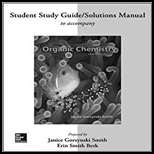
Concept explainers
(a)
Interpretation: The number of bonds broken and formed in Step [1] is to be identified. The sign of
Concept introduction: The
(b)
Interpretation: The number of bonds broken and formed in Step [2] is to be identified. The value of
Concept introduction: The chemical reaction in which energy is released during the formation of products is known as exothermic reactions. The energy released during the reaction is denoted by
(c)
Interpretation: The rate determining step is to be identified.
Concept introduction: The slow step in the reaction determines the
(d)
Interpretation: The structures for the transition state in both steps of the mechanism are to be drawn.
Concept introduction: The transition state is formed during the conversion of reactants into products in the chemical reaction. In an energy level diagram, it corresponds to the high potential energy along the y-axis.
(e)
Interpretation: An energy diagram is to be drawn if
Concept introduction: The chemical reaction in which energy is released during the formation of products is known as exothermic reactions. The energy released during the reaction is denoted by
Want to see the full answer?
Check out a sample textbook solution
Chapter 6 Solutions
ORGANIC CHEMISTRY-STUDY GDE...-W/ACCESS
- Draw an energy diagram for each reaction. Label the axes, the startingmaterial, product, transition state, ΔHo, and Ea.a.) a concerted reaction with ΔHo = −80 kJ/mol and Ea = 16 kJ/molb.) a two-step reaction, A → B → C, in which the relative energy of thecompounds is A < C < B, and the step A → B is rate-determiningarrow_forwardHow many transition states are involved in the following reaction?arrow_forwardExplain how you can tell from the energy diagram that the reaction with the catalyst in Fig. 8.4 isfaster than the reaction without the catalyst.arrow_forward
- Draw an energy diagram for the following SN2 reaction. Label the axes, the starting materials, and the product. Draw the structure of the transition state.arrow_forwardAt 25 ̊C, what is the free energy (∆G ̊) of a reaction with Keq = 10? Is this a thermodynamically-favorable reaction? 2. At 25 ̊C, what is the free energy (∆G ̊) of a reaction with Keq = 100? Is this a thermodynamically-favorable reaction? 3. At 25 ̊C, what is the free energy (∆G ̊) of a reaction with Keq = 0.1? Is this a thermodynamically-favorable reaction? 4. At 25 ̊C, what is the free energy (∆G ̊) of a reaction with Keq = 0.01? Is this a thermodynamically-favorable reaction? 5. What do you notice about the sign of ∆G ̊ and the magnitude of Keq? 6. What is the change in ∆G ̊ when Keq increases by a factor of 10? 100? Write 1-2 sentences to describe this relationship.arrow_forward(b) Consider the reaction of 1-bromobutane with a large excess of ammonia (NH3). Draw the reactants, the transition state, andthe products. Note that the initial product is the salt of an amine (RNH3+ Br - ), which is deprotonated by the excess ammonia to give the amine.arrow_forward
- Draw a reaction coordinate diagram for the following reaction in which C is the most stable and B the least stable of the three species and the transition state going from A to B is more stable than the transition state going from B to C:a.How many intermediates are there? b. How many transition states are there? c. Which step has the greater rate constant in the forward direction? d. Which step has the greater rate constant in the reverse direction? e. Of the four steps, which has the greatest rate constant? f. Which is the rate-determining step in the forward direction? g. Which is the rate-determining step in the reverse direction?arrow_forwardWhen Is the Reaction SN1, SN2, E1, or E2?arrow_forwarda. Draw an energy diagram for this reaction. be sure to label axes, starting materials, any reactive intermediates and products.b. Draw the transition state of this reaction. If an atom has a positive charge indicate it with sigma+/-.arrow_forward
 Organic Chemistry: A Guided InquiryChemistryISBN:9780618974122Author:Andrei StraumanisPublisher:Cengage Learning
Organic Chemistry: A Guided InquiryChemistryISBN:9780618974122Author:Andrei StraumanisPublisher:Cengage Learning
